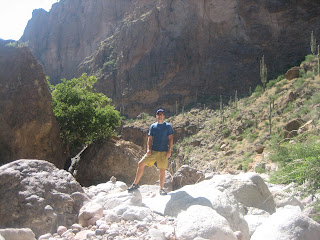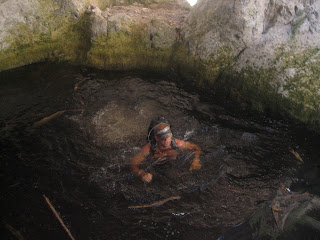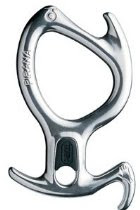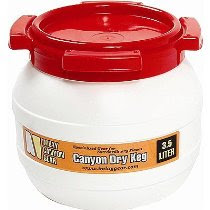ACA Canyon Rating SystemThe basic format of the ACA Canyon Rating System includes two digits. The first digit is numeric and represents the values described below related to terrain and rope work. The second digit is an alpha character representing the values described below related to water volume and current. Additional values may be added to represent relative risk and time/commitment. Ratings are cumulative. For example: descending a Class 3 canyon will require the skills listed under Class 3, as well as those listed under Classes 1 and 2.
NOTE: Ratings refer to descents in normal conditions, during what is considered the normal season for the canyon. Adverse conditions, such as higher than normal water volume or colder temperatures, will increase the difficulty of the descent.
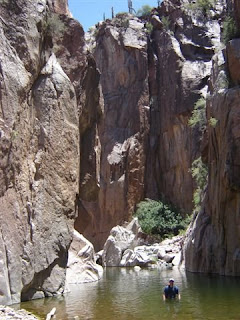
TERRAIN / TECHNICAL ROPE WORK
1 Canyon Hiking
Non-technical; no rope required. May involve some easy scrambling requiring the occasional use of hands for balance and support. See route description for more information.
2 Basic
CanyoneeringScrambling, easy vertical or near vertical climbing and/or down-climbing requiring frequent use of hands. Rope recommended for hand lines, belays, lowering packs and possible emergency use. Exit and/or retreat possible without ascending fixed ropes. See route description for more information.
3 Intermediate Canyoneering
Exposed technical climbing. Down-climbing could be difficult and dangerous; most people will rappel instead. Rope required for belays and single-pitch rappels. Obvious natural or fixed anchors. Retreat up canyon will require ascending fixed ropes. Basic pothole escape techniques (i.e. partner assist, counter-weights) may also be required. See route description for more information.
4 Advanced Canyoneering
Route may involve any combination of the following: 1) difficult and exposed free climbing and/or down-climbing, 2) climbing using direct aid, 3) multi-pitch rappels, 4) complex rope work (i.e. guided rappels, deviations, rebelays), 5) obscure or indistinct natural anchors, 6) advanced problem-solving and anchor-building skills. See route description for more information.
WATER VOLUME / CURRENT
A Normally dry or very little water. Dry falls. Water, if present, can be avoided and/or is very shallow. Shoes may get wet, but no wetsuit or drysuit required.
B Normally has water with no current or light current. Still pools. Falls normally dry or running at a trickle. Expect to do some deep wading and/or swimming. Wetsuit or drysuit may be required depending on water and air temperatures.
C Normally has water with strong current. Waterfalls. Expect to do some deep wading and/or swimming in current. Wetsuit or drysuit may be required depending on water and air temperatures.
NOTE: Water level in any canyon can fluctuate greatly from year-to-year, season-to-season, even day-to-day. If, upon arrival at a canyon, you discover the water volume/current is greater than indicated by the rating, descent will be more difficult than suggested by the route description. It will be necessary to reevaluate your decision to attempt the descent.
RISK / SERIOUSNESS (OPTIONAL)
R Risky
One or more extraordinary risk factors exist that could complicate the descent. Solid technical skills and sound judgment critical. Not recommended for beginners.
X Extreme
Multiple risk factors exist that will complicate the descent. Errors in technique or judgment will likely result in serious injury or death. Descent should only be attempted by expert canyoneers.
NOTE: The presence of an R or an X in a rating suggests that the canyon will involve higher than average risk. The absence of an R or an X does not suggest that there will be no risk. All canyoneering involves risk.
Risk factors include number and frequency of rappels, length of rappels (single- or double-rope) and exposure, anchor availability, anchor quality, route finding, obstacles, problem-solving, terrain encountered between technical sections, flash flood potential, availability of exits and high ground, water temperature, prolonged immersion, and difficulty of evacuation or rescue. Specific factors should be addressed in the route description.
TIME / COMMITMENT (OPTIONAL)
Half Day
I Short. Normally requires only a couple of hours.
II Normally requires a half day.
Full Day
III Normally requires most of a day.
IV Expected to take one long, full day. Get an early start. Bring a head lamp. Plan for possible bivy.
Multi Day
V Expected to take an average one and a half days.
VI Expected to take two or more days.
NOTE: Time estimates are based on average group of 6 people or less. Larger groups and less experienced groups will take longer. An accurate self-assessment of your abilities will be important. For some users, it may be adequate to refer to time in terms of half day, full day or multi day. Others may prefer a more specific estimate and choose to use the Roman Numeral Grade system common in traditional multi-pitch rock climbing.



